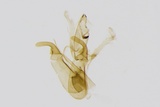Aproaerema vinella Bankes, 1898 Species
Last modified: Nov. 28, 2025, 5:56 p.m.
This species was new for Belgium in 2013 in LX. Hitherto a very rare and local species in the southern part of the country.
Details
- Classification
- Family: Gelechiidae > Subfamily: Anacampsinae > Tribus: Anacampsini > Genus: Aproaerema > Species: Aproaerema vinella
- Vernacular names
- Verfbrembandpalpmot (NL), Brighton Sober (EN)
- First mention in Belgium
- Wullaert S. 2015. Melding van minerende en andere zeldzame Lepidoptera in België met 10 nieuwe soorten voor de Belgische fauna (Nepticulidae, Tineida, Momphidae, Cosmopterigidae, Gelechiidae, Tortricidae en Geometridae). — Phegea 43(3): 50–63. On page 57. view page
- Status
-
Native
Distribution
Imago
Wingspan 10–12 mm. A small species with sexual dimorphism, females with a continuous band, males with a reduced band.
Dissection is essential to determine to species level.
Museum specimens
No pictures yet!Specimens in nature
No pictures yet!Caterpillar
Head ochreous; prothoracic plate mostly blackish; abdomen dark reddish brown to blackish brown; anal plate blackish, tiny (Gregersen & Karsholt 2022).
Bionomics
The larva lives first between top leaves spun together, then under leaves spun upwards on the shoot stalk, which it hollows out, but not nearly as thoroughly as that one. Also found feeding in spun flowers. Pupation in the larval habiation. The autumn generation which is full-fed can be searched for in winter, as the spun row of leaves does not fall off.
The adults become active from late afternoon and later come to light.
Flight periods
The adults have been seen from mid-May towards late September in two generations a year.
Observed on
- Host plant (species):
- Genista tinctoria
The larva lives on Genista tinctorium.
Habitat
It inhabits rough pastures and semi-dry grasslands.

